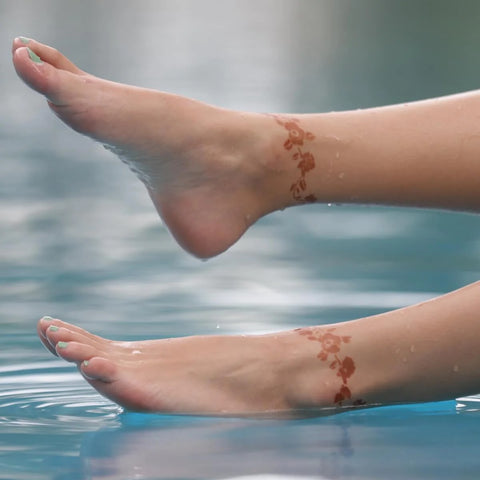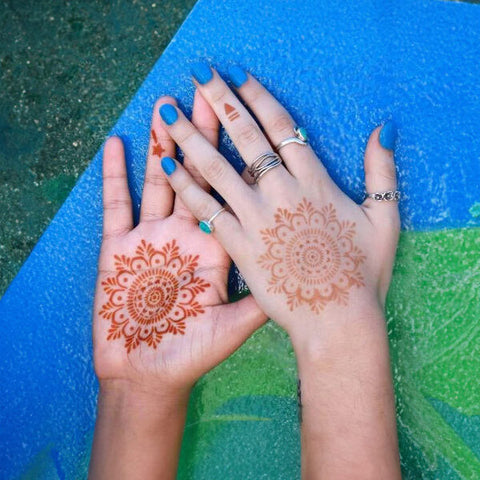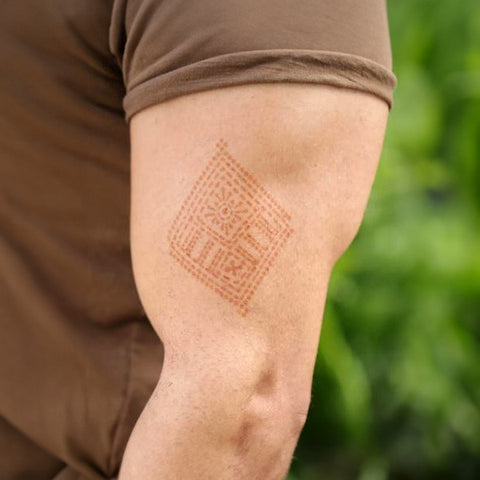Ever look at something and think, 'I could totally make that myself?' That's the Do It Yourself (DIY) spirit in action. DIY henna art involves creating designs without needing help from henna artists.
While we know henna is a natural substitute for chemical tattoos and dyes, not everyone delves into its history. We get it - not everyone is a history nerd. But over centuries, henna has played a significant role in various cultural and wedding rituals, forming deep cultural connections.
Therefore, learning the profound cultural history of henna can feel pretty rewarding.
Let's seize this moment to explore and value the cultural significance embedded in the art of henna tattoo making.
Exploring the Preservation of Culture Through Henna
Henna has played a substantial role in various cultures for millennia, serving as a medium for artistic expression, religious rituals, and medicinal practices. DIY henna (do-it-yourself) practices have long prevailed even after commercial henna cones became readily available.
Centuries ago, inhabitants of desert regions immersed themselves in henna, harnessing its properties to cool their bodies and regulate temperature. The intricate designs, especially mandala patterns, were believed to foster a spiritual connection with the universe.
In Middle Eastern and Asian cultures, henna is utilized in cultural expression and is prominently featured in wedding celebrations and festive occasions. Many ancient tribes viewed henna as adornment and a form of artistic expression, where symbols and patterns conveyed the community's heritage and identity.
Certain cultures use henna during social gatherings to foster bonds and strengthen community relations. Through the practice of applying henna tattoo art, ancestors have diligently passed down the rich culture and tradition associated with henna.
In today's modern era, henna transcends cultural boundaries and is embraced globally as a form of body art for widespread artistic expression.
However, amidst the global appreciation of henna, it is crucial to preserve its cultural roots and identity. This helps us protect the authenticity of henna against impurities or loss of quality.
Challenges Faced by Cultural Preservationists
While henna tattoo art has long been a cultural mainstay, particularly in weddings and other celebrations, cultural preservationists encounter challenges sustaining the traditional use of henna.
Here are some of the hurdles faced by those striving to uphold the authentic practice of henna:
1. Commercialization and Mass Production
The global adoption of DIY henna art has led to its commercialization and large-scale production. Unfortunately, this has resulted in the widespread practice of adding chemicals and artificial preservatives.
This commercial approach risks diluting the authenticity of henna and poses potential threats to users.
2. Authenticity Outside Henna-Origin Regions
Locating authentic henna becomes challenging in regions outside the countries of henna origin. This makes it difficult to preserve and promote the cultural significance of henna.
3. Reliable Suppliers for Original Henna
Finding trustworthy suppliers poses a significant challenge when selling genuine henna powder. The quest for authenticity is crucial in maintaining the traditional integrity of henna products.
4. Preserving Traditional Knowledge
Traditional knowledge about henna is pivotal for preserving the henna culture. However, this knowledge is diluted and sometimes miscommunicated while it passes through multiple generations. This poses a huge challenge to maintaining the essence of henna traditions.
Addressing these challenges is essential for cultural preservationists to sustain the rich heritage and significance of henna in its traditional context.
Risks Associated With Subpar Henna Products
Pay attention to the allure of cheaper henna cones & other products. Their affordability can have significant effects on human health and the environment.
Understand the authenticity of henna products and evaluate their ingredients to make informed decisions.
Let's delve into the concerns of these subpar henna products:
1. Chemical Additives and Preservatives
Low-quality henna products frequently contain chemical additives and artificial preservatives. These substances can be potent triggers for skin allergies, rashes, itching, and, in severe cases, even pose the risk of skin cancer.
2. Non-Adherence to Quality Standards
Cheaper henna products may not meet stringent product quality standards. Diluting henna with harmful contaminants and illegal additives is scaringly common! This affects the well-being of users and puts lives at significant risk.
3. Impact on Children
Substandard henna has particularly harmful effects on children, causing allergic reactions and causing permanent scarring.
Children have relatively sensitive skin. Thus, the risks associated with inferior henna pose a grave concern for the well-being of the younger demographic.
4. Misleading Product - Black Henna
A product named black henna has grown widely popular, claiming to create realistic, dark temporary tattoos. Contrary to its name, this product often lacks genuine henna and instead contains a chemical called PPD (paraphenylenediamine) for the dark tattoo stain.
Instances of severe skin reactions, including fatalities, have been reported in connection with the use of black henna.
Given these potential dangers, we urge you to exercise caution when purchasing henna products. Prioritize products that adhere to quality standards and avoid those that may compromise your health and well-being.
Meet Mihenna: All-Natural Products Preserving DIY Henna Art
Sometimes, the best part of DIY henna is the journey. It's about getting creative, getting your hands dirty, and maybe even making a few mistakes along the way. Mihenna embraces DIY art with open arms!
Experience high-quality body art with Mihenna’s diverse collection of henna powder products. Our items are sourced ethically and directly extracted from the Lawsonia Inermis plant. Our henna is entirely free of chemicals and added preservatives, ensuring safety on most skin types.
Choose from over ten tattoo kits featuring hand-picked stencil designs. These kits help you create realistic DIY tattoos using authentic henna. This option is especially appealing to cultural preservationists seeking genuine and traditional options. In addition to henna kits, we offer henna hair dye that strengthens your hair and helps combat dandruff and scalp-related issues.
Mihenna also has a treat for dark tattoo lovers! You no longer have to use harmful black henna or other dyes for darker or black tattoos. Discover the hottest thing for realistic, temporary tattoos - Jagua!
Explore our Jagua gel and Jagua tattoo kit, made purely out of the Jagua fruit (100% natural). By choosing Jagua, you bid farewell to potentially harmful black henna and achieve dark tattoos that resemble permanent black ink. Elevate your body art experience with Mihenna's natural and authentic products.
If you have trouble making free-hand henna designs, explore our extensive collection of henna tattoo stencils. Whether the occasion is wedding celebrations, bachelorette’s night, or a hangout party with your gang, these stencils come in diverse designs to help you create stunning designs in no time.
Step-by-Step Guide to DIY Henna Art
Selecting the right DIY henna kit involves choosing stencils that match the occasion. Each kit is bundled with essential henna components; the only distinction between the kits is the inclusion of different stencils.
The stencils are tailored to each kit's specific purpose. You can follow Mihenna’s step-by-step henna application process for a safe and enjoyable tattoo experience.
Henna tattoo art is embraced by people from different cultures, providing a creative outlet to recreate religious symbols or community motifs. This practice allows individuals to stay connected to nature and the universe, expressing their cultural identity in unique and beautiful ways.
Here are some stencils you can try on different occasions:
1. Floral Henna Tattoos

2. Mandala Designs

3. Geometric Henna Designs

4. Modern DIY Henna Art

Visit the Mihenna store to explore more stencil designs.
Caring for Your DIY Henna Art
Now that you've adorned yourself with stunning henna designs, it's essential to ensure their longevity and vibrancy.
To enhance the longevity of your henna tattoos, avoid exposing the fresh stains to the sun's UV rays and potent chemicals, including those found in swimming pools, heavy-duty work, and vigorous scrubbing.
Conclusion
Adopting traditional methods in DIY henna art ensures that henna's rich cultural heritage is preserved globally.
As you showcase your brilliance in crafting unique DIY henna designs, we encourage you to share your art with us.
Let's unite in the collective effort to preserve the authenticity of henna for future generations. Your passion for creativity will be vital in cultivating a community that contributes to developing eco-friendly beauty products through the art of henna.
Together, let’s make a lasting impact on sustainable and culturally rich beauty practices.
